
a web page by Don Roberson |
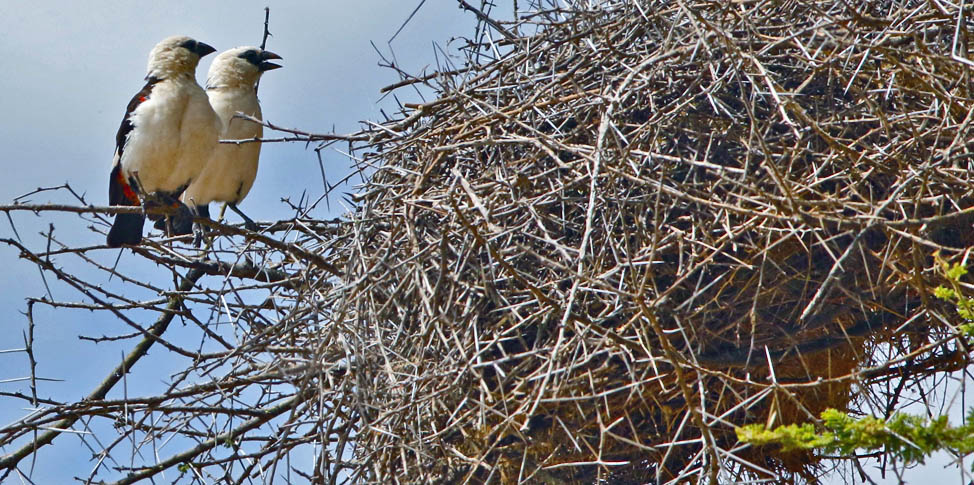 |
||||||
WEAVERS Ploceidae |
||||||
|
||||||
Speckle-fronted Weaver (left) is a widespread Acacia thornscrub species in southern Africa. It looks more like a finch than a weaver, and has been called "Scaly-feather Finch,""Scaly-fronted Weaver," or "Scaly Weaver" in many publications. Pairs, perhaps with the help of last year's young, build an untidy ball-nest, not all a woven masterpiece as is created by some weavers.
|
||||||
 |
||||||
| Among those weavers that actually do weave nests, that activity can take much of their time in the breeding season. It starts with choosing an appropriate material to use in the nest-building — as this Rufous-tailed Weaver (above) has chosen. Rufous-tailed Weaver is an endemic to Tanzania and in a monotypic genus (Histurgops). The weaving itself varies from species to species. For Cape Weaver (below left), a bird of open Acacia woodlands, it starts with a central ring at the opening of what will become a hanging globe. Vieillot's Weaver (below right), also builds a hanging ball-like structure, but is a species of primary lowland forest. Weaver nests are so characteristic that they occupy several pages of plates in Zimmerman et al.'s (1996) field guide to east Africa. |
||||||
|
||||||
|
||||||
 |
||||||
|
||||||
| Some weaver nests are fairly simple, like that of the thornscrub specialist with the great name — Donaldson-Smith's Sparrow-Weaver (below left; male is above the nest) — but others have elaborate entrance tunnels. Many weavers nest in huge colonies — densely-packed nests of Village Weaver (below center) are a common sight in many small African towns, where they look like ornaments at the tips of palm trees. And other weaves are exceedingly scarce and local, such as Black-chinned Weaver of Angola, southwestern Congo, and extreme southeasternmost Gabon (below right). [In 1999, when I first posted the digitized slides of Donaldson-Smith's Sparrow-Weaver and Black-chinned Weaver on my initial web page, these were about the only photos of those species available on-line. Digital photography has changed all that, of course, but as these were some of my first photos of weavers, distant digitized slides is the best I can do.] | ||||||
|
||||||
Colonial weavers, many of them in genus Ploceus (like the various species called "masked weavers"), set up territories and build nests before intensive courtship starts, and the male often displays hanging at the nest entrance. These males will be in full breeding plumage. In polygynous species, each male will build a series of nests, and try to attract as many females as possible. Nest that are not accepted by females are often demolished. The male may then rebuild at the same site. A single male Southern Masked-Weaver Ploceus velatus might build more than 20 nests over a three-month season (citation Craig 2010). Breeding seasons are tied to rains. In parts of Africa there are two rains — the summer rains and the winter rains — and there may be two breeding seasons annually (e.g., as in much of southern Africa). Closer to the tropics (e.g., in east Africa), the monsoon is often March-May. During our visit to Tanzania in June, nearly all the male weavers and bishops were in gorgeous breeding plumage. Visits in July or August often found most weavers in a much duller non-breeding plumage. These could be males in basic plumage (as above), or females or immatures at any time of year. An example of standard non-breeding plumage is this Black-headed Weaver in December in Ghana (below). Bill shape and color, and eye color, are key characters for the identification of non-breeding weavers. |
||||||
 |
||||||
 |
||||||
For the moment I'll use the Clements' taxonomy, but it may change in the future. Accordingly, using Ploceus for some African weavers, these include species that are scarce and local, but others that are are widespread and well-adapted to life with humans. Some Slender-billed Weavers in Queen Elizabeth II National Park in Uganda scavenge from breakfast plates at Mweya Lodge (above). In the Ngorongoro Crater, Tanzania, tourists are restricted to their land-rovers throughout the park except at one restroom and lunch spot. There, aggressive Speke's Weavers land on vehicles in efforts to scavenge crumbs from lunch (left).
|
||||||
| There are 17 species among the Euplectes widowbirds and bishops. Widowbirds are large and often long-tailed weavers of open grasslands. They also show dramatic differences in plumages. A widowbird example is Long-tailed Widowbird, comparing a displaying male in breeding plumage (below left) to a bird in basic plumage (below right). | ||||||
|
||||||
The nine species of Euplectes bishops likewise exhibit dramatic seasonal changes in plumage. Females, immatures, and non-breeding males can all be quite similar in plumage and decidedly drab. An example of a bishop in this protective dress is this female Black Bishop (right). Some of the bishop breed in small colonies, but many and solitary nesters, including Black Bishop. In many of the bishops, males construct a nest and then display nearby, seeking to attract a female. One Southern Red Bishop constructed 17 nests within 8 square meters of territory (Craig 2010). |
||||||
|
||||||
Forest weavers include a variety of typically black-and-red Malimbes (10 species in genus Malimbus) that join mixed species flocks there. These can often be difficult to see or photograph high in the canopy. Examples include Crested Malimbe (female; below left) and Red-headed Malimbe (below right). |
||||||
|
||||||
There are 7 species of Fody in genus Foudia, all of them on islands in the Indian Ocean, including Madagascar [yet another, from Réunon, is now extinct]. Seychelles Fody (right) is a threatened species endemic to the Seychelles. Drab in plumage, it may be threatened in competition with the bright Red Fody Foudia madagascariensis which has been introduced into the Seychelles. |
||||||
When not breeding, males molt into a very dull brownish plumage, turning them into inconspicuous, small, short-tailed weavers. In these conditions, male and females may both be red-billed and very similar (Zimmerman et al. 1996). Flocks of these inconspicuous birds may be found in savanna, or thornscrub. These photos (left and below) are from thornscrub habitat in Etosha NP, Namibia. |
||||||
 |
||||||
| The Ploceidae is a large and diverse family, and there is still much to say about them. I was interested to learn that, based upon the molecular analysis of De Silva et al. (2017), the most evolutionarily disparate weavers are the Grosbeak Weaver (genus Amblyospiza; a colony of which is shown near the top of this page); the buffalo-weavers, White-headed Buffalo-Weaver (genus Dinemalia; uppermost photo on this page) and Red-billed Buffalo-Weaver (genus Bubalornis; a fledgling at a nest site shown below left); Speckle-fronted Weaver (genus Sporopipes; the second weaver shown atop this page); Sociable Weaver (genus Philetairus; nest and birds shown near top of page); four species of sparrow-weaver (genus Plocepasser; Donaldson's-Smith Sparrow-Weaver is midway up the page; White-browed Sparrow-Weaver is below right); and two species of social-weaver (genus Pseudonigrita). |
||||||
|
||||||
Photos: The pair of White-headed Buffalo-Weaver Dinemellia dinemelli was in Tarangire NP, Tanzania, on 9 June 2017. The Speckle-fronted Weaver Sporopipes squamifrons was at Kalahari NP, South Africa, in March 2007. The Rufous-tailed Weaver Histurgops ruficauda was in Tarangire NP, Tanzania, on 8 June 2018. The nest-building Cape Weaver Ploceus capensis was at Nieuwoudtville Wildflower Reserve, South Africa, on 6 July 2005. The nesting Vieilliot's Weaver Ploceus nigerrimus was at Kibale Forest, Uganda, on 26 July 2002. The Taveta Golden-Weaver Ploceus castaneiceps was at Mkomazi, Tanzania, on 6 June 2018. The two photos of the colony of Grosbeak Weaver Amblyospiza albifrons were taken at Ngare Sero Mountain Lodge, Tanzania, on 6 June 2018. The two Sociable Weaver Philetairus socius, were at Etosha NP, Namibia, on 19 July 2005, and the nest engulfing a telephone was enroute in Namibia that week. The photos of an adult Principé Golden-Weaver Ploceus princeps, were at the small town of Santo António on Príncipé Island, Såo Tomé e Príncipe, in July 1996.. The nest, with attendant adult, Donaldson-Smith's Sparrow-Weaver Plocepasser donaldsoni was at Buffalo Springs NP, Uganda, in Nov 1991. The Village Weaver Ploceus cucullatus at Aboabo, Ghana, on 10 Dec 2013. The Black-chinned Weaver Ploceus nigrimentum was on the Batéké Plateau, Gabon, in July 1996. The Vitelline Masked Weaver Ploceus vitellinus was at Lake Baringo, Kenya, in Nov 1981. The female Black-headed Weaver Ploceus melanocephalus was at Narsia wetlands, northern Ghana, on 16 Dec 2013. The dining Slender-billed Weavers Ploceus pelzelni were at Mweya Lodge, Queen Elizabeth II NP, Uganda, on 23 July 2002. The aggressive Speke's Weaver Ploceus spekei was at Ngorongoro Crater NP, Tanzania, on 9 Aug 2002. The Seychelles Fody Foudia sechellarum was on Frégate I., Seychelles, on 11 Nov 1992. The male Long-tailed Widowbird Euplectes progne was displaying near Naro Maro, north of Mt. Kenya, Kenya, in Nov 1981; the non-breeding Long-tailed Widowbird was at Wakkerstroom, South Africa, in July 1996. The female and the male Black Bishop Euplectes gierowii were in Tarangire NP, Tanzania, on 9 June 2018. The male Southern Red Bishop Euplectes orix was at Ngorongoro Crater, Tanzania, on 11 June 2018, and so was the male Yellow Bishop Euplectes capensis. The male Zanzibar Red Bishop Euplectes nigroventris was at Lembeni, Tanzania, on 1 June 2018.The male Black-winged Bishop Euplectes hordeaceus was at Muheza, Tanzania, on 1 June 2018. The Yellow-mantled Weaver Ploceus tricolor was photo'd from the canopy walkway in Kakum Forest NP, Ghana, on 2 Dec 2013. The Crested Malimbe Malimbus crepitans was at Nsutu Forest, Ghana, on 6 Dec 2013. The male Red-headed Malimbe Malimbus rubricollis was in the Bigodi Swamp, Uganda, on 26 July 2002. The Seychelles Fody Foudia sechellarum was on Frégate I., Seychelles, on 13 Nov 1992. Both shots of Red-billed Quelea Quelea quelea were from Etosha NP, Namibia, on 21 July 2005. The fledgling Red-billed Buffalo-Weaver Bubalornis niger was near a nest in Tarangire NP, Tanzania, on 10 June 2018. The The White-browed Sparrow-Weaver Plocepasser mahali was in Samburu NP, Kenya, on 13 Nov 1991. All photos © Don Roberson; all rights reserved. Bibliographic note: Somewhat surprisingly, there is no "family book," as far as I know, but an excellent introduction, with great photos, is in Craig (2010). Literature cited:
|
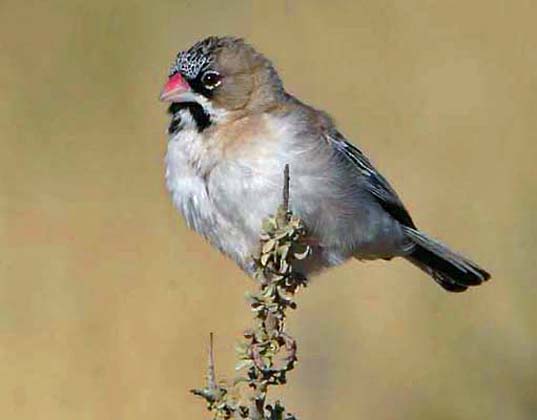 The Plocedae is a large family of primarily African weavers and relatives. The most famous attribute of the Weavers are the incredible nests many species weave. The pair of White-headed Buffalo-Weaver (above), with their untidy but huge nest, characterizes the thorn scrub savanna of eastern Africa. Yet many weavers do not weave nests, and others — such as bishops and widowbirds — have simple nests but feature brightly-colored males during the breeding season, but these become about as drab as a bird can be for the rest of the year. There are skulking forest weavers, including malimbes, that work the huge branches of giant trees like nuthatches. There are weavers in Asia and on Indian Ocean island. In all, the diversity of lifestyles in the Ploceidae is of great interest.
The Plocedae is a large family of primarily African weavers and relatives. The most famous attribute of the Weavers are the incredible nests many species weave. The pair of White-headed Buffalo-Weaver (above), with their untidy but huge nest, characterizes the thorn scrub savanna of eastern Africa. Yet many weavers do not weave nests, and others — such as bishops and widowbirds — have simple nests but feature brightly-colored males during the breeding season, but these become about as drab as a bird can be for the rest of the year. There are skulking forest weavers, including malimbes, that work the huge branches of giant trees like nuthatches. There are weavers in Asia and on Indian Ocean island. In all, the diversity of lifestyles in the Ploceidae is of great interest.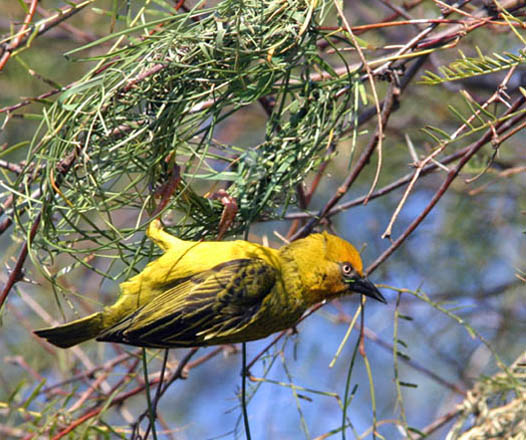
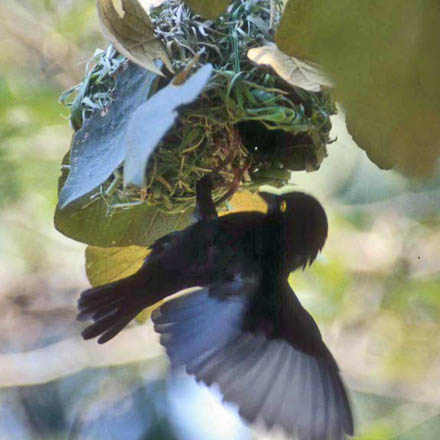
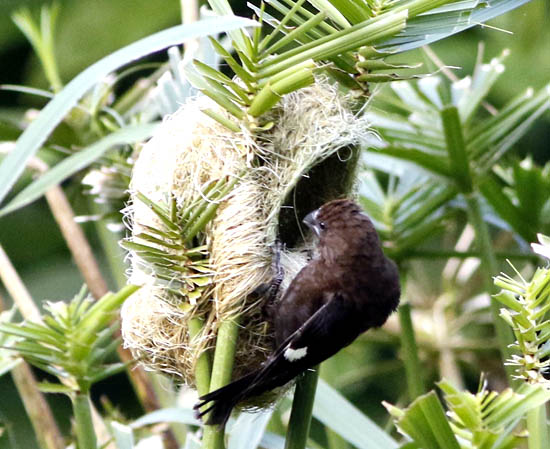 Many species of weavers are colonial and breed in groups from a few dozen to the hundreds. A variety of species build these colonies in wetlands or on islets that provide protection from mammalian or reptilian predators. Grosbeak Weaver (male at nest, right, and female in colony, below) is one of those species. So is the colorful Taveta Golden Weaver of east Africa (male just below).
Many species of weavers are colonial and breed in groups from a few dozen to the hundreds. A variety of species build these colonies in wetlands or on islets that provide protection from mammalian or reptilian predators. Grosbeak Weaver (male at nest, right, and female in colony, below) is one of those species. So is the colorful Taveta Golden Weaver of east Africa (male just below). 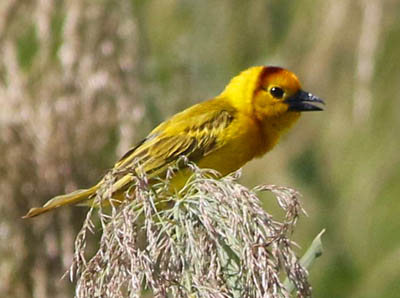
 Sociable Weaver of southern Africa (above) goes entirely overboard, constructing huge colonial nests that can overwhelm a telephone pole (right) and, sometimes, cause the entire structure to collapse.
Sociable Weaver of southern Africa (above) goes entirely overboard, constructing huge colonial nests that can overwhelm a telephone pole (right) and, sometimes, cause the entire structure to collapse.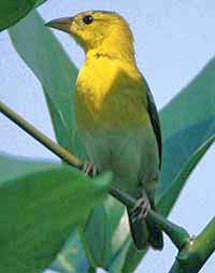
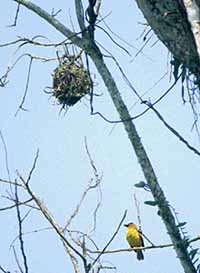

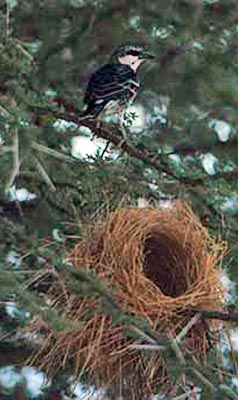


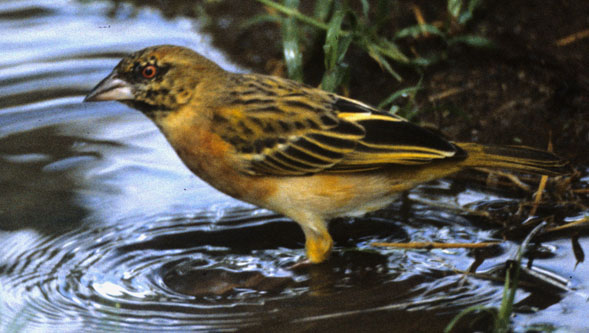 When I first visited Africa in 1981, the field guides only dealt with male weavers in breeding plumage. This left a host of birds unidentified, although we did have the good fortune to run into Terry Stevenson at the Lake Baringo Lodge where he identified this basic-plumaged male Vitelline Masked-Weaver (right) for us.
When I first visited Africa in 1981, the field guides only dealt with male weavers in breeding plumage. This left a host of birds unidentified, although we did have the good fortune to run into Terry Stevenson at the Lake Baringo Lodge where he identified this basic-plumaged male Vitelline Masked-Weaver (right) for us. 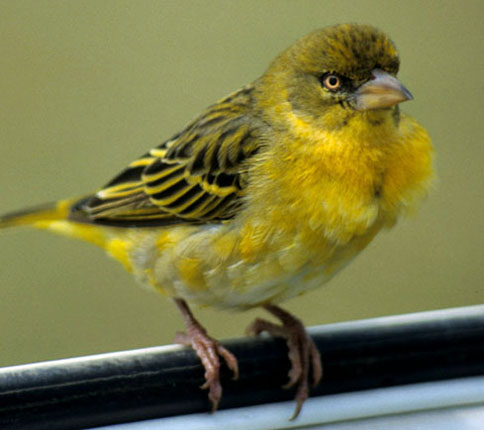 The taxonomy of the Ploceidae is unsettled. The Handbook of Birds of the World listed 17 genera (Craig 2010), and the current (2000) Clements' checklist has 16 genera. Both of these sources accept 63 species in genus Ploceus, accounting for over half of the world's weavers. I tend to think of weavers as an African family, but there are five species of Ploceus weavers in south Asia. Most of these are in India, but some range as far east as Sumatra and Java. There are two on Madagascar and two others in the Gulf of Guinea islands, leaving just over 50 species for mainland Africa. Yet the molecular evidence found genus Ploceus to be polyphyletic. De Silva et al. (2017) retained Ploceus for only the Asian species, and assigned all the African "Ploceus" to other genera (merging many into Malimbus).
The taxonomy of the Ploceidae is unsettled. The Handbook of Birds of the World listed 17 genera (Craig 2010), and the current (2000) Clements' checklist has 16 genera. Both of these sources accept 63 species in genus Ploceus, accounting for over half of the world's weavers. I tend to think of weavers as an African family, but there are five species of Ploceus weavers in south Asia. Most of these are in India, but some range as far east as Sumatra and Java. There are two on Madagascar and two others in the Gulf of Guinea islands, leaving just over 50 species for mainland Africa. Yet the molecular evidence found genus Ploceus to be polyphyletic. De Silva et al. (2017) retained Ploceus for only the Asian species, and assigned all the African "Ploceus" to other genera (merging many into Malimbus). 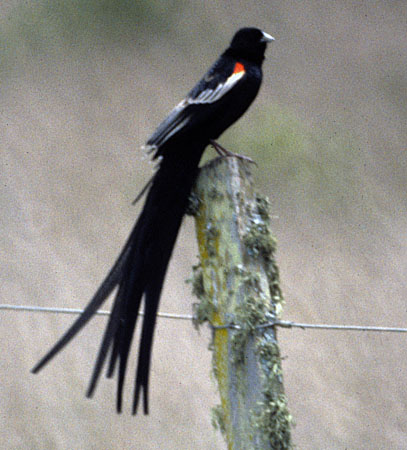

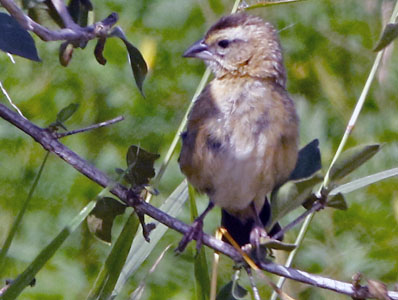


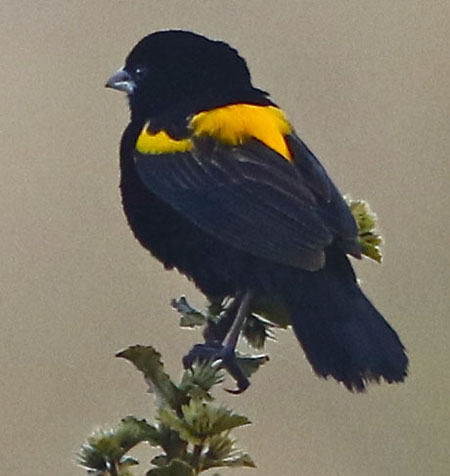
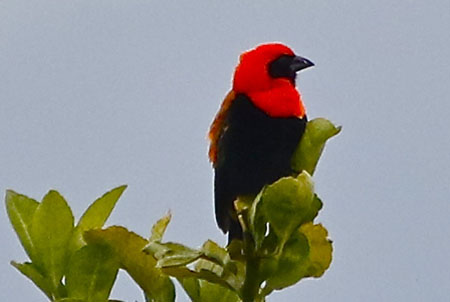

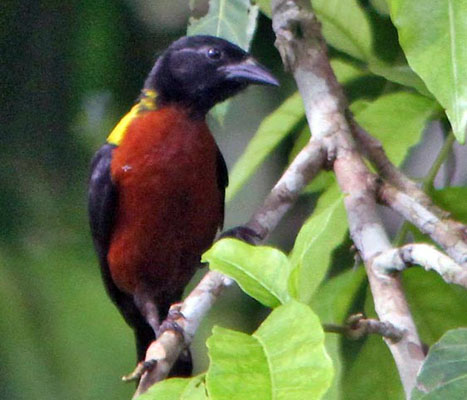 In contrast to the colonial weavers with polygynous breeding, there are forest weavers that form monogamous pairs, do not have seasonal plumages, and it which females are similar to males in many species. The Forest Weaver Ploceus bicolor of African equatorial and coastal woodlands is particularly memorable for its a wonderful song that recalls a calliope. More elusive weavers creep along giant tree limbs in the Congo Basin and in west African forests; an example is Yellow-mantled Weaver (left). This species is known to forages high in the forest interior, from middle levels or canopy, where it may sally above canopy to hawk insects or searches the bark of dead trees, moving up trunk in spiral route, in a posture like that of a woodpecker (citation).
In contrast to the colonial weavers with polygynous breeding, there are forest weavers that form monogamous pairs, do not have seasonal plumages, and it which females are similar to males in many species. The Forest Weaver Ploceus bicolor of African equatorial and coastal woodlands is particularly memorable for its a wonderful song that recalls a calliope. More elusive weavers creep along giant tree limbs in the Congo Basin and in west African forests; an example is Yellow-mantled Weaver (left). This species is known to forages high in the forest interior, from middle levels or canopy, where it may sally above canopy to hawk insects or searches the bark of dead trees, moving up trunk in spiral route, in a posture like that of a woodpecker (citation). 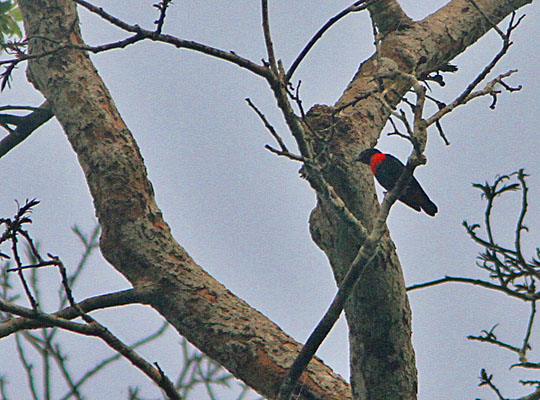


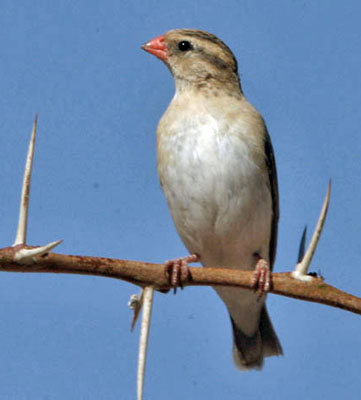 Three species of Quelea (genus Quelea) are considered sister to Fodies in a recent taxonomic assessment (De Silva 2017). One species, Red-billed Quelea (left and below) is often regarded as the most numerous non-domesticated bird on Earth, with the total post-breeding population that can peak at an estimated 1.5 billion birds (Craig 2010). Much of the breeding populations north of the equator moves south with rains fronts. At times these queleas will feed in flocks of millions of individuals, with birds that run out of food at the rear flying over the entire group to a fresh feeding zone at the front, creating an image of a rolling cloud. Queleas also need to come to water to drink twice a day, arriving in flocks that recall a plague of locusts. Although they breed colonially, the entire colony nest synchronously, thus breeding males do not attain the elaborate breding plumage, as do bishops and widowbirds (Craig 2010).
Three species of Quelea (genus Quelea) are considered sister to Fodies in a recent taxonomic assessment (De Silva 2017). One species, Red-billed Quelea (left and below) is often regarded as the most numerous non-domesticated bird on Earth, with the total post-breeding population that can peak at an estimated 1.5 billion birds (Craig 2010). Much of the breeding populations north of the equator moves south with rains fronts. At times these queleas will feed in flocks of millions of individuals, with birds that run out of food at the rear flying over the entire group to a fresh feeding zone at the front, creating an image of a rolling cloud. Queleas also need to come to water to drink twice a day, arriving in flocks that recall a plague of locusts. Although they breed colonially, the entire colony nest synchronously, thus breeding males do not attain the elaborate breding plumage, as do bishops and widowbirds (Craig 2010).
